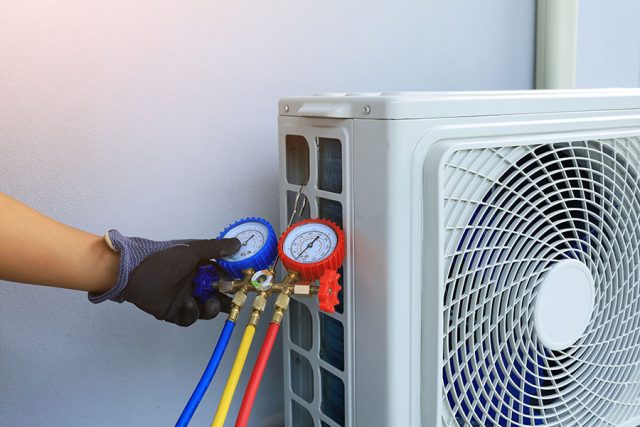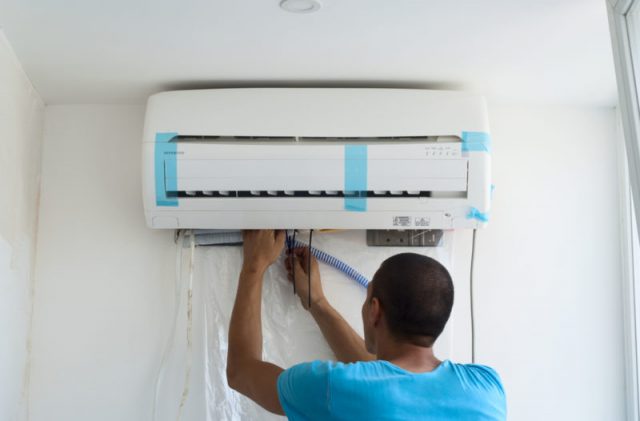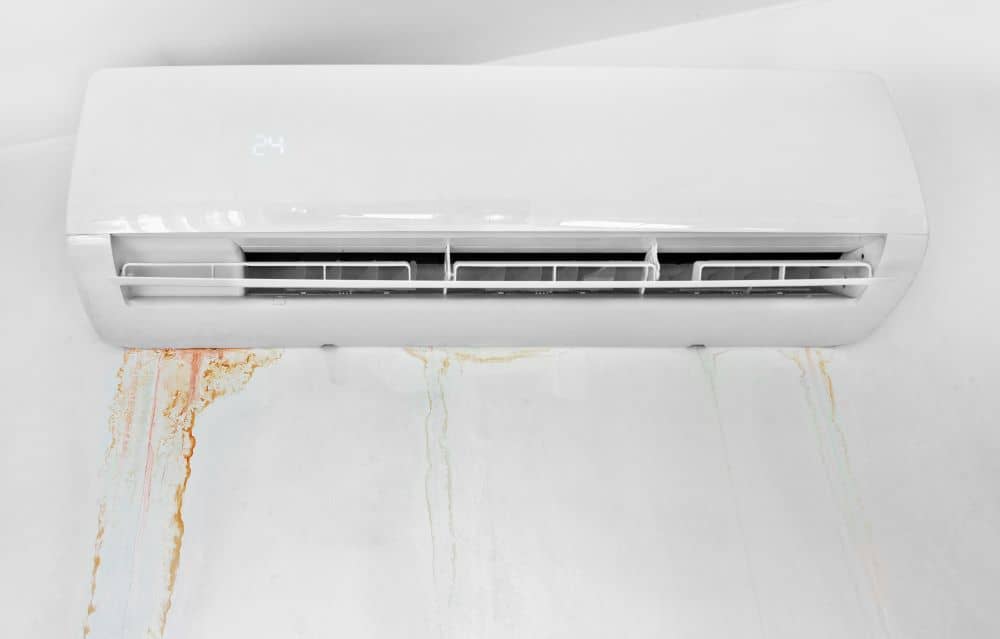Finding water dripping from your Ac unit can be alarming, but rest assured, you’re not alone in facing this common issue. In this comprehensive guide, we’ll delve into the intricacies of why your air-conditioning might be leaking water and provide clear explanations for each potential cause. By understanding these factors, you’ll be equipped with the knowledge needed to tackle the problem head-on and its operates smoothly.
Whether you’re dealing with a clogged drain line, a dirty air filter, or low refrigerant levels, we’ll explore each possibility in detail, offering practical solutions to resolve them effectively. Additionally, we’ll shed light on less obvious culprits like a damaged condensate pump, improper installation, and an oversized unit, empowering you to identify and address these issues with confidence.
Remember, maintaining your unit is essential for its longevity and efficiency. If you encounter challenges beyond your expertise, don’t hesitate to seek assistance from experienced professionals. For expert guidance and reliable solutions, reach out to the trusted team at ADK Kooling or call now at 0200 8831 8900.
COMMON REASONS:
Clogged Drain Line:

Sometimes, the drain line in your air conditioning unit can get blocked with dirt, dust, or even algae. When this happens, water can’t flow out properly, so it backs up and starts leaking out of your air-conditioning unit. It’s like a clogged drain in your sink – water can’t go down smoothly, so it overflows.
To fix it, you can use a wet/dry vacuum to suck out the blockage. Or, if you’re not comfortable doing it yourself, you can always call a professional to help. They’ll clear the line so that water can drain away properly, keeping it running smoothly.
Dirty Air Filters:

Think of the air filter in your air conditioning unit like a sieve. Its job is to catch dust, dirt, and other particles from the air before it gets circulated through your home. Over time, this filter can get clogged with all the stuff it catches, especially if it’s not cleaned or replaced regularly.
When the air filter gets dirty, it restricts the airflow in your air-conditioning system. This can cause the evaporator coil (which cools the air) to get too cold and freeze up. When the coil eventually thaws, it creates excess water that overwhelms the drain pan and starts leaking out of your air-conditioning unit.
To prevent this, it’s essential to check and clean or replace your air filter regularly. How often you need to do this depends on factors like the type of filter you have and how often you use your air-conditioning. Generally, it’s recommended to check your filter once a month and replace it every three months, or more frequently if you have pets or allergies.
Cleaning or replacing your air filter not only helps prevent water leakage but also keeps your air-conditioning running efficiently and improves the air quality in your home. It’s a simple maintenance task that can make a big difference in the performance and longevity of your air conditioning system.
Low Refrigerant Level:

Refrigerant is the substance responsible for absorbing heat from inside your home and transferring it outside, cooling the air in the process. If your air conditioning unit has a low refrigerant level, it means there isn’t enough of this crucial substance to effectively cool the air.
Several factors can contribute to low refrigerant levels, including leaks in the system or improper installation. When there isn’t enough refrigerant, the evaporator coil (which contains the refrigerant) may not be able to absorb enough heat to cool the air properly. As a result, the coil can become too cold and freeze up.
When the frozen coil eventually thaws, it can lead to excess water accumulating in the drain pan and leaking out of the air-conditioning unit. Additionally, low refrigerant levels can put strain on the compressor, potentially leading to further damage to your air-conditioning system if not addressed promptly.
To resolve this issue, it’s essential to have a qualified HVAC technician inspect your system to locate and repair any leaks. They will then recharge the refrigerant to the appropriate level, ensuring your air-conditioning can operate efficiently and effectively. Regular maintenance and prompt repairs are key to preventing low refrigerant levels and maintaining the performance of your air conditioning system.
‘’ Addressing your ac issues is like fine-tuning a complex machine. Each part plays a crucial role, and resolving problems ensures smooth operation. With proper maintenance and expert help, we keep your indoor environment comfortable and trouble-free ‘’
Damaged Condensate Pump:
A condensate pump plays a crucial role in the operation of an air conditioning system by removing excess moisture, or condensate, from the indoor air. This moisture is collected in a drain pan located beneath the evaporator coil and needs to be pumped out of the system to prevent water damage and maintain proper functionality.
When the condensate pump becomes damaged or malfunctions, it can disrupt the drainage process, leading to water accumulation and potential leakage from the air-conditioning unit. There are several ways in which a condensate pump can become damaged:
- Mechanical Failure: Over time, the mechanical components of the condensate pump, such as the motor or impeller, may wear out or fail due to regular usage or lack of maintenance. This can result in the pump no longer being able to effectively pump out the condensate.
- Clogging: Debris, dirt, or algae can accumulate inside the condensate pump, causing it to become clogged and preventing proper drainage. This can lead to water backup and overflow from the drain pan.
- Electrical Issues: Electrical problems, such as a blown fuse or malfunctioning wiring, can also cause the condensate pump to stop working. Without electrical power, the pump cannot function properly, resulting in water accumulation and potential leakage.
- Installation Errors: Improper installation of the condensate pump, such as incorrect positioning or inadequate support, can cause it to malfunction or become damaged over time.
When a condensate pump is damaged, it is essential to address the issue promptly to prevent further damage to the air conditioning system and potential water damage to the surrounding area. Depending on the extent of the damage, repairs may involve cleaning the pump, replacing damaged components, or replacing the entire pump unit.
Improper Installation of AC:

Improper installation of an air conditioning system can lead to various issues, including reduced efficiency, increased energy consumption, and potential safety hazards. Here’s a detailed look at the problems associated with improper installations:
- Incorrect Sizing: One common mistake during installation is selecting an unit that is either too large or too small for the space it’s intended to cool. An oversized unit may short cycle, turning on and off frequently, which can lead to increased wear and tear on components and higher energy bills. Conversely, an undersized unit may struggle to cool the space adequately, resulting in discomfort for occupants and inefficient operation.
- Poor Placement: Proper placement of the outdoor condenser unit and indoor evaporator coil is critical for efficient operation. If the outdoor unit is placed in an area with limited airflow or obstructed by objects such as vegetation or debris, it can lead to reduced airflow and impaired heat exchange, affecting the system’s performance. Similarly, if the indoor unit is installed in a location with inadequate ventilation or restricted airflow, it may struggle to distribute cooled air effectively throughout the area.
- Improper Refrigerant Charge: Incorrect refrigerant charging during installation can result in inadequate cooling or reduced efficiency. Overcharging or undercharging the system can lead to imbalanced pressure levels, compressor damage, and increased energy consumption. Proper refrigerant charging is essential for optimal system performance and longevity.
- Faulty Ductwork: Inadequate or poorly designed ductwork can restrict airflow, leading to uneven cooling, reduced efficiency, and increased energy consumption. Leaky ducts can also allow conditioned air to escape, resulting in wasted energy and higher utility bills. Proper sizing, sealing, and insulation of ductwork are crucial for maximising system performance and efficiency.
- Electrical Issues: Improper electrical connections during installation can pose safety hazards and lead to system malfunctions. Incorrect wiring or inadequate electrical protection can cause electrical fires, damage to components, and system failure. It’s essential to ensure that all electrical connections are properly installed and comply with local building codes and safety standards.
- Lack of Insulation: Inadequate insulation around refrigerant lines or ductwork can lead to heat gain or loss, reducing system efficiency and performance. Proper insulation helps maintain consistent temperatures and prevents energy loss, improving overall system efficiency and reducing operating costs.
Dirty Evaporator Coils:

The evaporator coil in your air conditioning system plays a crucial role in the cooling process. It absorbs heat from the air passing over it, which causes the refrigerant inside the coil to evaporate and cool down. Over time, however, the evaporator coil can become dirty due to the combination of dust, dirt, pollen, and other airborne particles.
When the evaporator coil becomes dirty, several problems can arise:
- Reduced Cooling Efficiency: A layer of dirt and debris on the evaporator coil acts as insulation, preventing the coil from absorbing heat effectively. This reduces the coil’s ability to cool the air passing over it, resulting in reduced cooling efficiency and longer run times for the unit.
- Frozen Coil: As the dirt and debris stuck on the evaporator coil, they can restrict airflow and cause the coil to become colder than it should be. In humid conditions, this can lead to the formation of ice on the coil, which further reduces airflow and cooling efficiency. A frozen evaporator coil not only impairs the performance of the unit but also increases the risk of damage to other components.
- Increased Energy Consumption: A dirty evaporator coil forces the unit to work harder to maintain the desired temperature, resulting in increased energy consumption and higher utility bills. The system has to run longer and more frequently to compensate for the reduced cooling efficiency caused by the dirty coil.
- Poor Indoor Air Quality: As air passes over the dirty evaporator coil, it can pick up contaminants and allergens trapped on the coil’s place. These pollutants can then be circulated throughout your home, compromising indoor air quality and potentially exacerbating respiratory issues for occupants.
To prevent these problems, it’s essential to regularly clean the evaporator coil as part of routine air-conditioning maintenance. This typically involves removing the coil from the air handler unit and gently brushing or extracting away any dirt and debris. In some cases, a specialised coil cleaner may be required to dissolve stubborn buildup.
Cracked Drain Pan:

The drain pan in an air conditioning system is a crucial component responsible for collecting condensate that forms as moisture is removed from the air during the cooling process. Over time, the drain pan can develop cracks or damage due to various factors, which can lead to water leakage and potential damage to the surrounding area. Here’s a detailed look at the implications of a cracked drain pan:
- Water Leakage: When the drain pan develops cracks or damage, water can leak out of the pan and accumulate around the unit. This can result in water damage to the floors, walls, ceilings, or other nearby structures, leading to costly repairs and potential mould or mildew growth if left unchecked.
- Reduced Efficiency: A cracked drain pan can also affect the efficiency of the air conditioning system. If water is not properly collected and removed from the system, it can interfere with the cooling process and reduce the system’s overall performance. This can result in longer run times, increased energy consumption, and higher utility bills.
- Corrosion and Rust: Cracks in the drain pan can expose the underlying metal or plastic material to moisture, leading to corrosion or rust over time. This can weaken the structural integrity of the drain pan and increase the likelihood of further damage or failure if not addressed promptly.
- Mould and Mildew Growth: Excess moisture from a cracked drain pan can create ideal conditions for mould and mildew growth, particularly in dark, damp areas such as the interior of the air conditioning unit or nearby ductwork. Mould and mildew can pose health risks to occupants and may exacerbate respiratory issues, allergies, or asthma symptoms.
To address a cracked drain pan, it’s essential to have it repaired or replaced as soon as possible by a qualified HVAC technician. Depending on the extent of the damage, repair options may include patching the cracks with epoxy or sealant or replacing the entire drain pan with a new one. In some cases, the technician may also need to inspect and repair any underlying issues contributing to the damage, such as improper installation or corrosion.
Noticed signs your AC is making some trouble? It’s probably time to call in the experts.
All sorts of little things can go wrong with the air-conditioning unit. Some are very minor and can be fixed at home procedures or a quick clean. But others may require a specialist diagnosis and repairs.
But be warned: it could get you into trouble if you attempt to make the repairs yourself without the right training or know-how. It isn’t advisable, and it might call an engineer from ADK Kooling to work on them if the problem isn’t resolved.
If you live within the M25 and your air-conditioning unit is showing one or more of these telltale signs of dying — then I’d like to suggest you give one of our specialists a call.
Some reasons to consider us include:
- Our engineers can get out to you in just a few hours.
- Our call-outs are set at fixed prices — with no sneaky hidden extra charges.
- We carry lots of spare and replacement parts, so it’s extremely unlikely you’ll have to wait around for us to order one.
- We can guarantee a 90-days warranty on all our repairs
Looking for new air- conditioning unit for your home or small office. Explore discounted deals on Rimy
Find out more about our air-conditioning repairs & get an engineer out ASAP.

